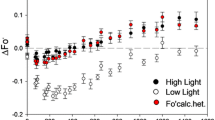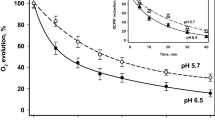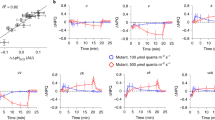Abstract
With an aim to improve our understanding of the mechanisms behind specific anion effects in biological membranes, we have studied the effects of sodium salts of anions of varying valency in thylakoid membranes. Rates of electron transport of PS II and PS I, 77K fluorescence emission and excitation spectra, cyclic electron flow around PS I and circular dichroism (CD) spectra were measured in thylakoid membranes in order to elucidate a general mechanism of action of inorganic anions on photosynthetic electron transport chain. Re-distribution of absorbed excitation energy has been observed as a signature effect of inorganic anions. In the presence of anions, such as nitrite, sulphate and phosphate, distribution of absorbed excitation energy was found to be more in favor of Photosystem I (PS I). The amount of energy distributed towards PS I depended on the valency of the anion. In this paper, we propose for the first time that energy re-distribution and its valence dependence may not be the effect of anions per se. The entry of negative charge (anion) is accompanied by influx of positive charge (protons) to maintain a balance of charge across the thylakoid membranes. As reflected by the CD spectra, the observed energy re-distribution could be a result of structural rearrangements of the protein complexes of PS II caused by changes in the ionic environment of the thylakoid lumen.
Similar content being viewed by others
References
Aroti A, Leontidis E, Dubois M, Zemb T (2007) Effects of monovalent anions of the Hofmeister series on DPPC lipid bilayers Part I: swelling and in-plane equations of state. Biophys J 93(5):1580–1590
Barber J, Chow WS (1979) A mechanism for controlling the stacking and unstacking of chloroplasts thylakoid membranes. FEBS Letts 105:5–10
Canaani O, Barber J, Malkin S (1984) Evidence that phosphorylation and dephos-phorylation regulate the distribution of excitation energy between the two photosystems of photosynthesis in vivo: photoacoustic and fluorimetric study of an intact leaf. Proc Natl Acad Sci USA 81:1614–1618
Chow WS, Kim EH, Horton P, Anderson JM (2005) Granal stacking of thylakoid membranes in higher plant chloroplasts: the physicochemical forces at work and the functional consequences that ensue. Photochem Photobiol Sci 4:1081–1090
Dér A (2008) Salts, interfacial water and protein conformation. Biotechnol Biotechnol Equip 22:629–633
Garab G (1996) Linear and circular dichroism. In: Amesz J, Hoff AJ (eds) Biophysical techniques in photosynthesis, advances in photosynthesis, vol. 3. Kluwer, Dordrecht, pp 11–40
Garab G, van Amerongen H (2009) Linear and circular dichroism in photosynthesis research. Photosynth Res 101:135–146
Garab G, Kieleczawa J, Sutherland JC, Bustamante C, Hind G (1991) Organization of pigment protein complexes into macrodomains in the thylakoid membranes of wild-type and chlorophyll-b-less mutant of barley as revealed by circular-dichroism. Photochem Photobiol 54:273–281
Govindjee (1995) Sixty-three years since Kautsky: chlorophyll a fluorescence. Aust J Plant Physiol 22:131–160
Gross EL, Prasher SH (1974) Correlation between monovalent cation-induced decrease in chlorophyll a fluorescence and chloroplast structural changes. Arch Biochem Biophys 164:460–468
Holm JK, Várkonyi Z, Kovács L, Posselt D, Garab G (2005) Thermo-optically induced reorganizations in the main light harvesting antenna of plants. II. Indications for the role of LHCII-only macrodomains in thylakoids. Photosynth Res 86:275–282
Hopes AB, Mathew DB (1983) Further studies or proton translocations in chloroplasts after single-turnover flashes. I. Proton uptake. Aust J Plant Physiol 10:363–372
Izawa S, Good NE (1966) Effects of salts and electron transport on the conformation of isolated chloroplasts. II. Electron microscopy. Plant Physiol 41:544–552
Jajoo A, Bharti S (1995) Possible role of anions in the regulation of energy distribution between the two photosystems. Ind J Exp Biol 33:67–72
Jajoo A, Dube A, Bharti S (1994) Mg2+ induced lipid phase transition in thylakoid membranes is reversed by anions. Biochem Biophys Res Commu 202:1724–1730
Jajoo A, Bharti S, Govindjee (1998) Inorganic anions induce state changes in spinach thylakoid membranes. FEBS Letts 434:193–196
Jajoo A, Bharti S, Mohanty P (2001) Evaluation of the specific roles of anions in electron transport and energy transfer reactions in photosynthesis. Photosynthetica 39:321–337
Jajoo A, Bharti S, Kawamori A (2005) Interaction of chloride and formate at the PS II donor and acceptor side. J Bioenerg Biomembr 37:49–54
Kim M, Ulibarri L, Keller D, Maestre MF, Bustamante C (1986) The psi-type circular dichroism of large molecular aggragates. III. Calculations. J Chem Phys 84:2981–2989
Kuwabara T, Murata N (1982) Inactivation of photosynthetic oxygen evolution and concomitant release of three polypeptides in the photosystem II particles of spinach chloroplasts. Plant Cell Physiol 23:533–539
Murakami S, Packer L (1971) The role of cations in the organization of chloroplast membranes. Arch Biochem Biophys 146:337–347
Neilson JAD, Durnford DG (2010) Structural and functional diversification of the light harvesting complexes in photosynthetic eukaryotes. Photosynth Res doi:10.1007/s11120-010-9576-2
Papageorgiou GC (1989) Permeabilized cyanobacteria: a model system for photosynthetic and biotechnological studies. In: Barber J, Malkin R (eds) Techniques and new developments in photosynthesis research. Plenum, New York-London, pp 449–467
Porra RJ, Thompson WA, Kriedemann PE (1989) Determination of accurate extinction coefficients and simultaneous equations for assaying chlorophylls a and b extracted with four different solvents: verification of the concentration of chlorophyll standards by atomic absorption spectroscopy. Biochim Biophys Acta 975:384–394
Richter ML, Homann PH (1984) The involvement of amino groups in electron transfer between plastocyanin and P700 in photosystem I subchloroplast particles. Photobiochem Photobiophys 8:125–131
Sanderson PW, Lis LJ, Quinn PJ, Williams WP (1991) The Hofmeister effect in relation to membrane lipid phase stability. Biochim Biophys Acta 1067(1):43–50
Sinclair J (1987) Changes in spinach thylakoid activity due to nitrite ions. Photosynth Res 12:255–263
Singh-Rawal P, Jajoo A, Mathur S, Mehta P, Bharti S (2010) Evidence that pH can drive state transitions in isolated thylakoid membranes from spinach. Photochem Photobiol Sci 9:830–837. doi:10.1039/C0PP00055H
Tikkanen M, Nurmi M, Suorsa M, Danielsson R, Mamedov F, Styring S, Aro EM (2008) Phosphorylation dependent regulation of excitation energy distribution between the two photosystems in higher plants. Biochim Biophys Acta 1777:425–432
Tiwari A, Jajoo A, Bharti S, Mohanty P (2007) Differential response of chloride binding sites to elevated temperature: a comparative study in spinach thylakoids and PSII membranes. Photosynth Res 93:123–132. doi:10.1007/s11120007-930-z
Wong D, Govindjee (1979) Antagonistic effects of mono- and divalent cations on polarization of chlorophyll fluorescence in thylakoids and changes in excitation energy transfer. FEBS Letts 97:373–377
Author information
Authors and Affiliations
Corresponding author
Rights and permissions
About this article
Cite this article
Singh-Rawal, P., Zsiros, O., Bharti, S. et al. Mechanism of action of anions on the electron transport chain in thylakoid membranes of higher plants. J Bioenerg Biomembr 43, 195–202 (2011). https://doi.org/10.1007/s10863-011-9346-7
Received:
Accepted:
Published:
Issue Date:
DOI: https://doi.org/10.1007/s10863-011-9346-7




